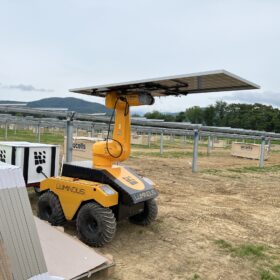Climate change think-tank Beyond Zero Emissions (BZE) has partnered with the green group Environment Centre NT (ECNT) to produce a vision for an immediate renewable future in the Northern Territory. The 10 GW Vision is an ambitious one, especially if it is to be achieved by 2030.
Ten gigawatt is ten times the Territory’s current electricity generation capacity, and twenty times its current renewable energy target. The Territory is currently the lowest producer of renewable energy in Australia with just 5% of its total energy generation coming from renewables. However, the new report finds that 10 GW, considering the abundance of the NT’s natural resources, is a more than achievable goal.
“Installing 10 gigawatts of renewables is not a particularly challenging undertaking – at least in terms of scale, cost or land required,” the report states. Presently, there are several gigawatt-scale project proposals in Australia, such as the 11 GW Asian Renewable Energy Hub on the books for the Pilbara, the 1.1 GW Kennedy Energy Park in central north Queensland, and the 4 GW Walcha Energy Hub in regional NSW.
Ten gigawatts of large-scale solar would cost around $20 billion in 2019 prices, according to the report. This number is insignificant in comparison to the alternatives – consider recent gas projects such as the $54 billion Ichthys LNG project.
Until now, the Northern Territory has missed out on the renewables boom taking place elsewhere in Australia, BZE finds, but the region has effectively unlimited potential to generate solar power. In fact, the NT government has calculated that the area required for the 450 MW of solar it requires to meet its current 50% renewable energy generation goal is the equivalent of 0.08% of just the Victoria River Downs cattle station, or The Big Run as it is better known. Therefore, the entire 10 GW would only require 1.8% of the same cattle station.
PV-powered vision
Because of the NT’s abundant sunshine and rapidly falling cost of solar, BZE believe that the initial push (2020-2025) for the 10 GW Vision will rely largely on solar PV. Though the NT’s generation would need diversification in the long run, solar PV is well positioned to produce the majority of the NT’s renewable energy and act as a catalyst for wider, long-lasting economic renewal.
If the Territory is to secure its economic future and pursue game-changing projects like generating hydrogen for export, it will first need the experience, and local cost reduction, provided by megawatt scale renewable projects. The 10 GW Vision, like the Asian Renewable Energy Hub, relies on private investment, and the Territory will need experience in renewable development and infrastructure in order to attract such large-scale private investors.
In addition to the attraction of private investors, BZE recognises that the 10 GW Vision requires long-term commitment from the NT Government with substantial policy initiatives to invigorate local actors. The long term return for the government would be substantial. BZE calculate that the 10 GW Vision could form the building block of the Territory’s future growth across all its sectors, beginning, of course, in the renewables industry itself, which could see 8,000 new jobs and over $2 billion in revenue by 2030.
Author: Blake Matich
This content is protected by copyright and may not be reused. If you want to cooperate with us and would like to reuse some of our content, please contact: editors@pv-magazine.com.








2 comments
By submitting this form you agree to pv magazine using your data for the purposes of publishing your comment.
Your personal data will only be disclosed or otherwise transmitted to third parties for the purposes of spam filtering or if this is necessary for technical maintenance of the website. Any other transfer to third parties will not take place unless this is justified on the basis of applicable data protection regulations or if pv magazine is legally obliged to do so.
You may revoke this consent at any time with effect for the future, in which case your personal data will be deleted immediately. Otherwise, your data will be deleted if pv magazine has processed your request or the purpose of data storage is fulfilled.
Further information on data privacy can be found in our Data Protection Policy.